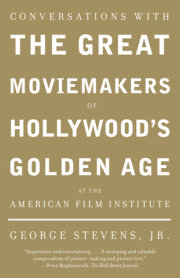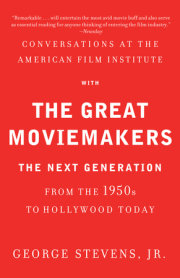It sounds like bragging, but we didn’t borrow from the bank. We kept a certain amount of money aside and financed our own pictures. In a way we gambled a little heavier than some people do at Las Vegas, but we always got away with it. HAROLD LLOYD (Born in Burchard, Nebraska, 1893—Died 1971)
There are few more fondly remembered screen images than the young man with horn-rimmed glasses desperately clinging to the hand of a clock high over Los Angeles. That young man was seventy-six years old the night he joined twenty aspiring filmmakers who had earlier seen a thirty-five-millimeter print of Kid Brother in the old library of the Doheny estate in Beverly Hills. For most of them this was their first look at Harold Lloyd, a comic genius whose screen triumphs four decades earlier had made him one of the world’s most famous faces, an international star who produced his films and took responsibility for every detail. He never took director credit, but he was the guiding light of his comedies.
Lloyd owned his films and preserved them, but kept such a tight grip on them that he missed the opportunity for the kind of revivals enjoyed by his contemporary rivals, Charlie Chaplin and Buster Keaton. In fact, most filmgoers remember him only for the famous clock scene in Safety Last! because it is seen so often in film history compilations. But in the 1920s audiences crowded into theaters and howled at Lloyd’s antics in Grandma’s Boy, Girl Shy, The Freshman, The Kid Brother and Speedy—which were always accompanied by a live orchestra. I remember Lloyd insisting that a piano was all right for two-reelers, but you had to have a big orchestra for features.
He was slight at five foot nine, optimistic and genial. When he arrived at AFI he seemed more like someone’s happy uncle than a man whose success had enabled him to build a forty-four-room house in Beverly Hills with a hundred-foot waterfall, a nine-hole golf course and a staff of sixteen full-time gardeners.
Lloyd gave the world thrills and laughs. His era was the magical time of grand movie palaces, huge audiences and shared laughter, and his legacy includes some of the finest comedies ever made. It’s just as well that Lloyd, a perfectionist who died two years after his AFI seminar, didn’t live to see the postage-stamp screens of the modern shopping mall.
I invited him to be AFI’s first speaker because I felt it important to establish this series with a pioneer who went back to the roots of American filmmaking, a pioneer who understood the importance of AFI’s goal of preserving our motion picture heritage.
Lloyd’s friend and colleague King Vidor joined the fellows in the questioning.
HAROLD LLOYD September 23, 1969 May I just say that being a guest here tonight, I feel highly honored being in on the initial shove-off, as it were, of the AFI Conservatory. Certainly I’m sure that everyone here, every guest you have, is rooting that it’s going to go tremendous places. I’m happy to say that I have the honor also of being one of the original men on the Academy of Motion Picture Arts and Sciences, and to tell the truth, I don’t believe it was as big as this when we started. I was on the original board that elected Doug Fairbanks, Sr., president, and it has gone quite a ways, so I’d say that if your institute here gathers momentum and keeps going, you may well outdistance the Academy Awards. I hope that takes place.
This picture that you’ve just seen, Kid Brother, well, we had a little problem with that one. It is what I call a “character comedy.” I made two different types of pictures. I made what we call “gag pictures,” for instance Safety Last!, where I climbed a building and hung on a clock. But Kid Brother is more what I call a character comedy because we start slow, we plant the character, we very carefully try and let it grow, letting the picture gain momentum as it goes on through to the end. I think we accomplished that. Now, where we took quite a chance with Kid Brother was in putting a fast-moving half-hour composite at the front of it with mostly comedy business and gags. After you’ve gone that length of time and then stop—and start a picture from scratch to build your character—you are taking quite a chance.
I used to hear stories about how adroit you and the cameramen were at slowing down right in the middle of a scene. Did you have the same cameraman with you all the time? Yes, Walter Lundin. He was with me for years and years.
These were all done with hand-cranked cameras? That’s right.
I was amazed at the scene with the bus running through what seemed to be normal traffic. They must have had everything else on the street move at a snail’s pace. No, that was done right down here in the streets. I mean, we had our own traffic. We did that in New York, too. In fact there was a picture called Speedy where I had two horses pulling a horse cart down the thing, and we’d block off about three blocks. We looked like we had the whole police force there with us. We had our own traffic. It wasn’t cheating. Of course, we had a terrible time on that one. One of our own cars got in the way of the horses, and to keep from running into the car, the man had to pull the horse and go down the subway. It didn’t hurt the horse, I’m happy to say, but we never used him again. He was a little shy after that. But these scenes you saw here were shot with our own traffic and generally with the car in front or in back with the camera. The camera was taking every bit as much of a chance.
The bus was going very much faster than anything else? We had that bus on a cantilever and the bus tipped itself, so as we’d go around the corner we’d tip it and over you’d go. One thing you had to watch was when you’re hanging over the edge—which I was—that you didn’t get your leg caught in between the tip. But we actually did all that stuff. You see, you can’t slow your camera down too much because the pedestrians look jerky. In fact in the film they might be jerky, but we didn’t want them to look that way.
What speeds did the cameras run at? I’d say they were down around fourteen frames per second, except in some places they might drop it even more. As you were saying, the cameramen in those days had a certain technique and an ability to really keep that crank going. The majority of the audience think we cranked that way, they think we wanted it to go exceptionally fast, and they accept that as the way we made it. Of course, everyone here knows it’s not true, but no matter how many times you tell people it was cranked at a much different speed, and that you had to get a much smaller number of frames through the camera than you do now and therefore it’s got to go much faster, they don’t hear you at all. As much as it’s been repeated, I don’t think the majority of people have any idea about speed. They don’t care, really. I guess if they did care, your picture wouldn’t be worth a damn. But the students here would know the difference.
Now, a picture that I was always afraid of was Safety Last! because I had several scenes in there and they moved pretty fast. But I put it in front of an audience, and it didn’t seem to spoil the laughs any. I showed it recently to a group of high school students at Hollywood High and it went as well as it ever did with the crowd I first made it for. So why am I worrying about speed?
Do you think audiences today like the film because of the fast pace? In some cases they might, and in other places, no. But I think if your comedy is basic enough and they’re with you—they’re laughing with you as well as at you—I really don’t think it makes too much difference.
There’s a thematic element in The Kid Brother, and I’m curious about how it evolved and how you feel about it now. Basically the theme is “brains over brawn.” In the film I have two older brothers who are behemoths, and I’m the puny little fellow, the boy who thinks and in the end outwits those people who just use their muscles. In a lot of the pictures—especially the character comedies—we tried to have some kind of hidden theme in there. I guess if you boil it down to “be yourself” that would be about the shortest you could make it.
But when it comes to the theme of a picture, we’re supposed to be comics, and the audience came to get a chuckle or two. I’d go back to another picture we made that Hal Roach and I had a little contention on, and we were both right, in a way. Hal Roach and I made Grandma’s Boy and we previewed it, and it kind of lay there, to a certain degree. The film had a fine theme in it, that of “mind over matter.” The boy’s a terrific coward and his grandmother recognizes that. To help him out she gives him a talisman that she says his grandfather had owned. His grandfather had been more cowardly than he, but with this talisman he [the boy] just can’t fail, and he becomes a great hero. Of course, at the end he finds out that the talisman was just a handle to her umbrella. He finally realized he’d accomplished these things himself. But we didn’t put enough comedy in it, so the audience didn’t laugh as much as they should have.
Did you ever preview any of your pictures? I think we were one of the very first, even back in the old one-reel days, to start previews. We used to go out here to Glendale. I can remember the old gentleman who was manager of the theater. His name was Howard and he would always put on tails to come out to explain to the audience what was going on, that this picture had never been shown before and that we expected to do a lot more work on it. He made it clear that the audience was the judge and so forth. After the preview of Grandma’s Boy we went back and Hal said, “Harold, you’re a comic, you’ve got to get laughs. Let’s go back to work.” So we went back and worked for months putting comedy-business gags all over the place. The second time we previewed it, it blossomed. It was fine and it’s been fine ever since. In fact, the picture probably did as much for us as anything because it was the first feature picture we made. We didn’t intend for it to be a feature—we started it as a two-reeler. In fact, our group—Hal and myself, our staff—we were thoroughly entrenched in making two-reel pictures and doing pretty well with them. But this had such a nice theme that it just kept growing, and we let it grow. It grew into a five-reel picture. When it came to getting more money for it, the exhibitors were a little loathe to pay us more than they had been paying us for two-reelers. They were perfectly happy with the two-reelers, so we couldn’t go anyplace with this longer film. Eventually they offered us a little more, but not so much. So we went down to Broadway and we took a third-run house that was showing newsreels and we put the picture in there. They thought we were off our rocker, but the picture ran nineteen weeks. It established a tremendous record, and from then on we had no trouble.
We ran into the same thing on Safety Last! Sometimes you had to take the film to Chicago, which was tied up with various circuits: Lubliner and Trinz, Balaban and Katz, one or the other. We felt that we had something a little out of the ordinary with Safety Last! because it had the thrill in it that audiences were reacting to very strongly in those days. We could get nowhere with the circuits, so we took a house on Michigan Boulevard called Orchestral Hall and established a fine record there, and had no trouble with Lubliner and Trinz, and Balaban and Katz after that.
Are you planning to rerelease Grandma’s Boy? Here’s the way I look at it. If I thought there was a demand with the public for the pictures, I would love to release a great many of them, but I feel very loathe to release them unless I feel they’re really wanted and desired. What I mean by that is, even though I have stayed off the screen for many years and I think I’m quite well known with the nostalgia group, I’m known very little, if at all, with a great many cinemagoers. Now, what’s the use of releasing pictures in the theaters if audiences don’t know who they’re going to see? The general public is different today. That’s my situation, and it’s the reason I took it to Hollywood High down here. Somebody presented the opportunity to me, and I went down there and found that this generation is more “hip,” I think, than the generation I made them for. They’ve seen more television. Their whole response was tremendous because they didn’t miss a gag, even things that were a little subtle. They got them right away. I went around and did a symposium with about eleven universities. They had a student congress and the picture went about as well there as I’ve seen it.
What about showing the films on television? I could go on television very easily if I wanted to; I’ve had many offers. My price is a little high. I don’t mind telling you what I’m asking. They’ve come up close to it, but they haven’t come up. I want three hundred thousand dollars for myself for two showings. That’s a high price, but if I don’t get it, I’m not going to show it. That’s it.
How did it happen that you kept control of your films? Well, that was kind of fortunate. I know because Buster Keaton was a very good friend of mine, and I knew Laurel very well, and Hardy, and they got into situations where they weren’t able to retain control of their pictures. At first I made pictures for Roach, and Roach had complete control. Later on he came to me and said, “Harold, you don’t need me anymore. I’ve got so many pictures of my own to do, we might as well just go our own way.” Which we did, and it was I think the most amicable way that any two people could have parted.
From that time on I produced and financed my own pictures. It sounds like bragging, but we didn’t borrow from the bank. We kept a certain amount of money aside and financed our own pictures. In a way we gambled a little heavier than some people do at Las Vegas, but we always got away with it. In one picture we put in close to a million dollars. No one wants to lose that much, which you can very easily in the picture business. But by doing that I was able to control my own pictures. Pathé, who owns so many of my Roach films, turned them over to me, and I bought a number of them from Roach. So I either own or control practically all of them.
Back then it seemed to be a time when the people who were making films finished a film and then forgot it, and that’s why so many have been lost. You seem to have a respect for what you did. Well, we’re going through the throes right now of trying to keep a lot of one-reelers from being lost. Nitrate, as you all know, is a very dangerous form of film and very tricky. It turns into jelly. Of all the pictures ever made on nitrate negatives, more than half have been lost. I lost an awful lot of films. They were stored in New Jersey, in a place called Bonbrook. Everybody stored them there, and they had a tremendous fire and all of ours were lost. And I had a fire at my house with nitrate. Fortunately, I didn’t keep the ones that I treasure the most there. Nitrate film, for no reason at all, just explodes sometimes. They’re such nasty fires because of the fumes and everything. That’s why a great many films have been lost, and a lot of others have been lost because no one preserved them. They just didn’t think they were valuable.
You once said that comedies have a better chance than dramatic pictures today. Why do you think that? We didn’t make a local type of humor. We were smart enough to realize that they had to be understood in India or Tokyo or Holland as well as here, so we tried to make what I consider to be a basic type of humor—that they would understand too. It’s not local humor, so it’s understood today and is fresh today, if the picture was well made. The gags that you see—the Keatons, the Chaplins, and the Laurel and Hardys—some of them are just as fresh today as you could possibly dig up to put in the modern picture.
Did you start with a story or with an idea for a gag? We never had a script until we made a talking picture. When I say we didn’t have a script, we had a script in our mind, up to a point. The first thing to find was a character. It was the thing that identified me as Harold Lloyd, the man with the glasses. This was a little contrary to what most of my contemporaries did. Most of them played exactly the same character. Chaplin played his little tramp, Keaton was the stone face, Laurel and Hardy were practically always the same. But in the pictures that I did, one character could be an introvert, a little weakling, and another could be an extrovert, the sophisticate, the hypochondriac. Each one thought differently. Well, they looked alike in appearance, with the glasses, which I guess you’d call a typical American boy. Still, the sophisticate thought entirely differently than the character in Grandma’s Boy or the character in The Freshman.
How did the introduction of sound affect you? Some of the comedians—in fact most all of them—weren’t equipped for sound. Now, my going into sound was sort of like when we went into features. It was an evolutionary thing. It was difficult to keep the same kind of pace in sound pictures as you did in the silents. Another thing is that everybody went sound happy. They thought that because you were making a sound picture you had to talk all the time. It was much cheaper to go verbal. You can get verbal laughs much easier than you can get sight gags. You had to pay some nice, handsome prices for your gagmen, as they were called.
In my case it wasn’t that way because I had completed a picture called Welcome Danger. I had finished it as a silent, and when we previewed it for about the third time, there was a one-reeler sound comedy on the bill and they howled at it. It had the punkest gags, but they were laughing at the pouring of water, the frying of eggs—it didn’t matter what—the clinking of ice in a glass. We said, “My God, we worked our hearts out to get laughs with thought-out gags and look here: just because they’ve got some sound, they’re roaring at these things.” I said, “Let’s get on the ball. We ought to try and make this a sound picture. Let’s see how much we can keep of it and dub it”—we didn’t know much about dubbing in those days either—“and we’ll make the rest of it over.” That was the one that cost me the most—close to a million dollars. It also made the most money. Welcome Danger is the one made in underground Chinatown.
So you see, for me it was a kind of natural transition because I had the silent picture to start with, so it had silent technique to it, and the dubbing was horrible. We just didn’t know what we were doing. We had a screen up there and we’d run the picture with X marks on it and tried to hit those things. Cutters didn’t know too much about cutting them in. I look at the film today and groan, but it worked fine back then because they liked the sound gags. It didn’t turn out to be one of our best pictures, but it has its good points.
Did you ever improvise? The way we would ad-lib was that we would have a number of gagmen in our office, as many as four to eight of them. They were very expensive—in those days you paid eight hundred dollars. That’s quite a figure. I’d come in and they’d throw ideas at me. I knew what we wanted and we worked out a theme or story line which could be changed at any moment. Maybe I can explain it best with two pictures. When we made Safety Last!, we knew that the boy had to come to the city to make good and he was going to pretend to make good before he actually had, and that the girl was going to come on thinking he had made good, and then he would have to find some way to do it. One of the devices was climbing. He was going to get his pal—who was an iron girder worker—to climb this building. We filmed the climb first and we were very pleased with it. We thought we had something. Now, from there we went back and started the picture. But that, as I say, was a gag picture.
We tried the same thing with The Freshman. We went out to the Rose Bowl and for two weeks did comedy business. We tried to play a football game and got nowhere at all. All the dailies were just sad. We had to start at the beginning because it’s a character comedy that needed to be built on a particular idea. We knew that the whole picture was really a boy who wanted to go to college with the idea of trying to be very popular. He goes with a completely erroneous idea of how to go about it. So he’s in nothing but trouble all the time, and something pulls him out. That’s the kind of story line we worked with.
In trying to be spontaneous, we’d work out a series of scenes for the day. We knew we had little islands of what we were going to do, but in between those set ideas, we’d ad-lib. By the time we had shot it four times, little islands would be left out and maybe we’d change the whole idea, we’d have all new business, things came to us that we didn’t think of in the gag room. That’s the reason you got adept at ad-libbing, creating as you went along, thinking of different things.
Is there anything you can tell us about the basic structure of the gags in your films? When you study comedy, there are many times when you’ve got to judge things very carefully. Is it good to let the audience in on your gag, to let them enjoy knowing what’s going to happen, or should you surprise them? I’ve had many gags that we had to shoot both ways because we weren’t sure. I would say that three-fourths of the time surprise is best, but sometimes it turns out to be much funnier when the audience is in on it and enjoying what’s happening to the comic.
In The Monkey, I’m in the hold of this ship and this big heavy who has just killed a man is trying to kill me. I try to stand up to him. I fight him, but he knocks me down very easily and finally throws me up against the bulkhead. I’m very exhausted, and he takes this iron belaying pin and hits me over the top of the head—which should have crushed my skull—but all I did was blink and, of course, he’s astounded. So he looks at me with a ferocious look and takes it again and hits me much harder. The iron pin bends a little and all I do is blink. The next time he hits me so hard he bends the belaying pin and is flabbergasted. He looks at me and I run. There’s an iron bracket on the ship—he didn’t hit me at all—he was hitting this iron bracket that was over my head, so he could hit me all day long. Now, is it better for the audience to know he’s hitting the iron bracket, or is it better for them to find out when I run away and there’s the bracket? We previewed it both ways.
Which way worked? The surprise way worked, because then we had a “topper.” Another example is in Safety Last! where I’m caught in an office and I’ve rung a bell, and the office boy comes in. I’m not supposed to be there. I’m trying to show off to my girl. In order to do it, I show him this dollar bill and he sees it and he’s happy to get it. So I tell him to take the wastepaper basket out and empty it, and I drop the dollar bill in it. He gives me a wink, but as he starts out, I crumble a piece of paper and say, “Oh, boy, come here. You’d better pick that up.” As he picks that up, I reach in [the wastepaper basket] and get my dollar bill back. Now, for those kinds of things you want the audience in on it.
I don’t believe you ever took credit on your pictures as a director. Were you actually in control? I think that for more than sixty percent of the pictures I could have taken full credit on the direction. I took writers who had never been directors out of the writing room and gave them credit for directing the pictures. My thinking was that the audience was giving me credit I needed by being the main comic, so why did I have to have the credit for doing the direction? I enjoyed being the comic, and it helped the boys.
Do you have anything like a philosophy of comedy? Gags are done from inside. You must feel them, you must know how they are, you must time them, you must react to them. If you could get ten comics doing the same piece of business, one will invariably do it much funnier if it suits him, if it’s his type of business. You must have that feeling of comedy within you, and my character was a funny character—that’s the reason I used him. He belied his appearance when he put on horn-rimmed glasses for a mollycoddle type. He was a kind of weakling. I got the idea of wearing the glasses from a picture where the minister wore glasses and he took after this girl who had been kidnapped. He got the girl and had a terrible fight with her fellow. He licked the fellow and he was very casual about the whole thing. He just belied his appearance—you didn’t think he could fight, or do anything else.
One thing I had to do was to stay within the semblance of reasonability, for example, when I was on the side of the building in Safety Last!
Lots of people would have ruined the whole thing because they’d do something impossible and then ask you to believe them from then on. But practically all the gags I did, with one or two exceptions, were things that could actually happen. Many of the others didn’t do that. They got into situations where they did something that spoiled the whole thing. Bob Hope used to try and mix oil and water all the time because he’d go along with a cartoon gag and then he’d want a very serious gag. You can’t make the audience go both ways. Preston Sturges used to do something very dramatic and then he’d do this other thing. The audience would get confused; they don’t know where you want to go. If you want to make it a cartoon type of picture, then make it a cartoon. There’s nothing wrong with that. It may be better than the other way. But stick to it. Don’t try to blend the two and ask the audiences to believe both things.
Copyright © 2007 by Edited and with an Introduction by George Stevens, Jr.. All rights reserved. No part of this excerpt may be reproduced or reprinted without permission in writing from the publisher.







